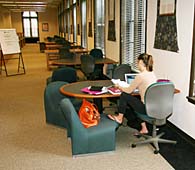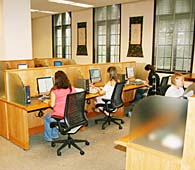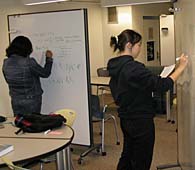Library
Responds to Students' Changing Needs
 People don’t learn
the way they used to. Students these days seek more interactive
approaches to studying, research, problem-solving and analysis.
They incorporate numerous forms of media into their learning
and presentation, using computer-generated graphics, DVDs,
PowerPoint software and the Internet. People don’t learn
the way they used to. Students these days seek more interactive
approaches to studying, research, problem-solving and analysis.
They incorporate numerous forms of media into their learning
and presentation, using computer-generated graphics, DVDs,
PowerPoint software and the Internet.
These new methods require common
learning spaces and technology to accommodate their needs.
Those in Neilson Library have
answered those needs with the construction of a new network
of spaces they refer to as the Information Commons. It includes
several rooms on the first floor, which have been refurbished.
The Mair Reference Room, for example, has had a facelift
with the removal of its wall-to-wall bookshelves and addition
of new, more comfortable furniture. On any given day, natural
light streams in through its windows and reflects off the
blond wood desks and kiosks.
Perhaps most importantly, the
reference room has been equipped with a computer at every
kiosk, each connected to the Internet—only accessible with
a Smith account—as well as multimedia machinery, such as
DVD players and digital recorders.
 “This room is being used in a way it wasn’t
being used two years ago,” notes Christopher Loring,
director of libraries, who has overseen the transformation
in Neilson. “It’s a nicer space now with more
light, newer furniture. And it’s only open to people
in the college community. People like to be in a space that
feels nice.” “This room is being used in a way it wasn’t
being used two years ago,” notes Christopher Loring,
director of libraries, who has overseen the transformation
in Neilson. “It’s a nicer space now with more
light, newer furniture. And it’s only open to people
in the college community. People like to be in a space that
feels nice.”
The reference room also
includes several tables at which students can collaborate. “One of the things we know
is that students need to work together,” says Loring. “They
also like to be together.”
Toward that end, several spaces
to accommodate group work have been sectioned off amid
the stacks on the first floor. These spaces are supplied
with white boards, large plasma projection screens and media
machinery.
“There’s a real
lack of group space for study on campus,” says Loring. “Now,
in these new spaces, people can work together.”

Natalie Flores ’08 (left) and Joyce Cheung ’09 take
advantage of the library's new collaborative workspace. |
Engineering students Natalie
Flores ’08 and Joyce
Cheung ’09 recently took advantage of the library’s
collaborative spaces to work together on thermal dynamics
equations.
“I like the fact that this space is located here in
the library,” said Flores. “It’s convenient,
and it’s always available.”
“If you’re here with a group, you can all study
together,” said Cheung. “We can use more spaces
like this [on campus].”
The library’s Information
Commons is the result of a strategic review conducted in
2002-03 by library administrators and the Committee on
Education and Technology. The commons also includes changes
to the second-floor periodicals room, and the addition
of the Quantitative Learning Center on the second floor.
The changes in Neilson Library reflect a trend nationally
to create similar centers to accommodate multiple methods
of learning, Loring says. The University of Massachusetts
in Amherst recently completed its own Learning Commons.
“Libraries will always be about the book and we don’t
want that to change,” says Loring. “But we’re
creating resources that respond to the changing needs of
students and the way they learn.” |























